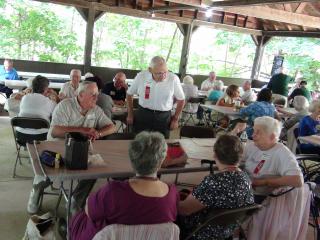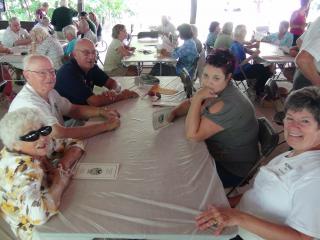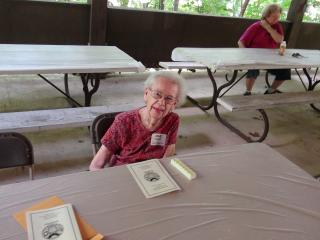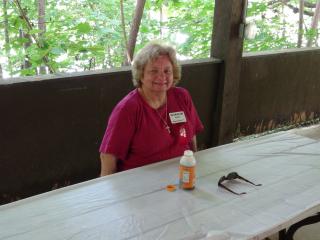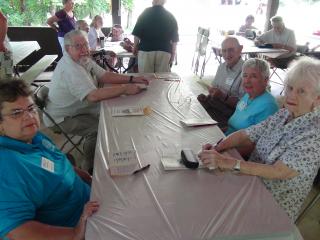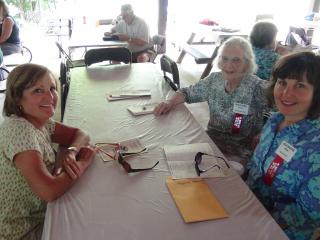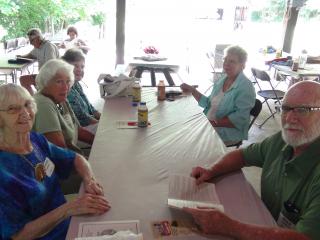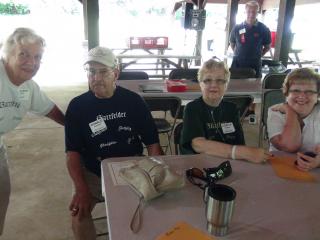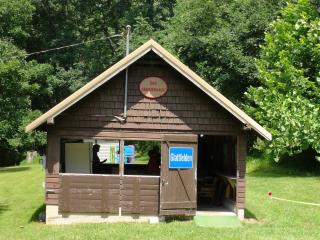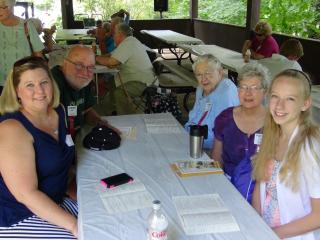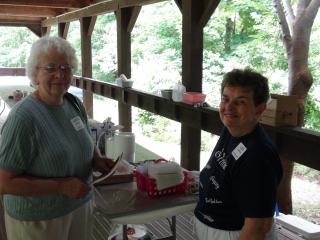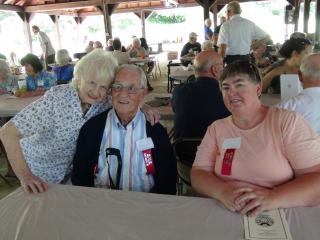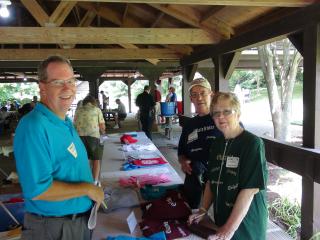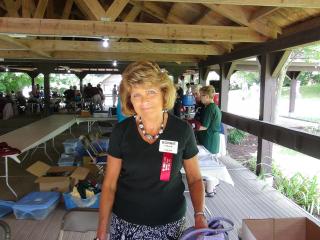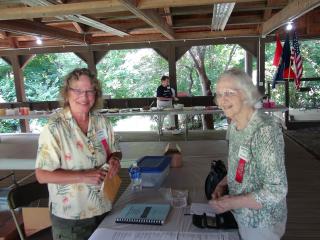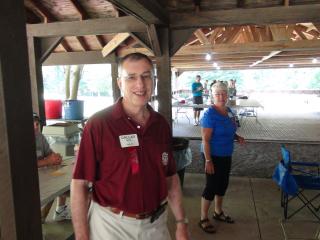Our 109th Reunion was held Saturday, July 26th and Sunday, July 27th, 2014
Our theme was:
The Glattfelders in the Spanish-American War and World War I
About 110 people attended this year’s reunion, which was held Sunday, July 27 at Heimwald Park. The weather was pleasant and everyone enjoyed the catered lunch of chicken and fixings.
Association President Rev. Tom Shelley welcomed everyone and Ricky Gladfelter led everyone in singing the reunion hymn.
Association board member Rev. Dr. Dennis Gable led devotions and the memorial service.
Continuing the series on Glattfelders in this nation’s wars, our theme dealt with the Spanish -American War and World War I.
Historical Committee members Philip Glatfelter and Jean Robinson gave talks on the wars as follows.
Glattfelders in the Spanish - American War
Continuing with our series on Glattfelders in this nation’s wars, Historical Committee member Philip Glatfelter, son of Dr. Charles Glatfelter, gave this talk on the Spanish - American War.
With the mysterious sinking of the battleship USS Maine in the harbor in Havana, Cuba, the United States was soon drawn into the Spanish - American War.
In George Prowell’s history of York County, he states, “... the outspoken opinion of American statesmen on this subject (meaning Spain’s treatment of the Cubans) found disfavor among the Spanish leaders in Cuba and on February 15, 1898, the Maine, one of the large battleships of the American navy ... resting in the harbor of Havana ... was blown up, and two officers and 264 American sailors lost their lives. ... On April 11, President McKinley issued a
call for 125,000 troops to serve. ...” (The U.S. officially declared war on Spain on April 25.)
“... Meantime, the land forces, under General Shafter, had defeated the Spaniards in the battle of San Juan Hill, July 1 and 2, 1898, which was the last serious conflict during the war with Spain ... (and included, as many of you may recall, Teddy Roosevelt and his Rough Riders).
This war officially came to an end with the Treaty of Paris December 10, 1898.
“When the war opened, Governor Hastings of Pennsylvania issued a call for the National Guard to enlist in the United States service. At that time, Company A of York and Company I of Wrightsville belonged to the eighth regiment. ... The company was mustered ... into service May 12, 1898, and went into camp with the regiment at Mount Gretna near Lebanon. ...”
An undated newspaper article describes in detail the farewell
given these two Guard companies marching east on Market Street to take up training at Mount Gretna. The article states, “ ... Bands and groups of veterans, sons of veterans, volunteers and children ... marched as an escort. The Spring Garden band played and there was waving of flags. Volunteer groups fell in behind the Guard units and followed along West Market Street. It was a cold and blus tery day, but spirits were high, marching off to claim victory on the battlefield.”
Among those joining Company A, 8th Regiment, was Clarence A. Glatfelter of York, born November 5, 1876, to Alexander and Fannie Gotwalt Glatfelter. He serv ed from April 28, 1898, to March 7, 1899. He was a carpenter by trade, as was his father, and continued this work after his service time.
Stewart E. Glatfelter followed in his brother’s footsteps, when on May 8, 1898, he joined Company A as a private. Born in January 1881, Stewart resided in York. After his discharge in 1899, he resided in Detroit, Michigan.
Both brothers, Clarence, along with his wife Florence Small, and Stewart, and his wife Annie Haugh, are buried in Prospect Hill Cemetery in York.
A third Glatfelter to serve from York County was Harry R., born August 29, 1875, son of John Glatfelter. Before his enlistment, he resided in Philadelphia for a time and later in New Jersey. However, upon his death in 1952, he was buried in Mount Rose Cemetery in York.
The solders’ names were taken from the roster of Spanish - American War veterans’ grave markers found at the York Heritage Trust Library.
Unfortunately, it would be less than 20 years later that the U.S. and York County would find themselves called upon to register and serve in a time of war, this time in the Great War, or the war to end all wars.
⇔
Glattfelders in World War I
Historical Committee chairperson Jean Robinson then spoke on World War I.
At the 1918 Picnic, Association Historian Samuel Gladfelter gave this reunion message, which, in part, went something like this: “... But still more to be proud of, when the call to arms came for freedom and liberty in this new world ... five sons from the little home on yonder hill, kissed mother good - bye and gave their service that we too might enjoy freedom and democracy in America. They have left the spirit of bravery for righteousness sake engrossed in the life of every generation since then and from the days of Colonial victory in 1776. This great patriotic family lent its quota for the defense of the stars and stripes made holy by the chivalry of our forefathers. Today, once more are we called to record our protest against autocracy and tyranny and the
blood of this generation is just as red as that of our ancestors and freedom will reign and the Keiser will be licked. ...”
On April 6, 1917, the U.S. officially entered the Great War with
the sinking of the ocean liner “Lusitania.” Our Glattfelder fathers, sons, brothers and cousins registered in response to the call
made by President Wilson and Congress on May 18, 1917, the official order of registration for war duty. And by June 14, 1917, American forces under General John J. Pershing arrived in France.
At least 31 Glattfelders who resided in York County served in this Great War. Among them was Arthur J. Gladfelter, York City, his obituary reading that “Mr. Gladfelter was a World War veteran having served in the 658th Aero Squadron of the U.S. Army as a
cook. He served in France and England from February 10, 1918 to May 7, 1919.
Pvt. Earl G. Glatfelter of Yorkana, son of Leo and Amanda Glatfelter, was an Army Veteran of World War I, according to his obituary April 2, 1980.
Clark W. Gladfelter was a “Veteran of World War I, discharged as a sergeant from the 7th Co. 154th Depot Brigade.”
Upon returning to civilian life, Clark went on to join the Casper Glattfelder Board as a director in 1927 and served as President from 1931 - 1934. He was instrumental in helping place the Bupp’s Union memorial at the cemetery commemorating our Glattfelder heritage.
In reading over information and historical data for the era, I came across “Three Hundred and Nine Reasons Why Ice Plant Co No. 301 is the Best Outfit in France.” The document reads, in part, “... The 301st outfit was sent. This special and technical unit (to France) comprised of individuals whose pre-war training ... made them valuable in ice and cold storage plant construction. ... Will we ever forget these long months of toiling and grinding with shovel and pick, concrete mix ... to bring construction to completion ... in a beautiful section of choice French swamp land to build a place to receive frozen beef ... then reshipped to every nook and corner of France, wherever a detachment of Yanks could be found. ...”
These men were building cold storage units for food for the military troops. KP duty to ok on another meaning.
At least two Glattfelder soldiers were part of this endeavor:
Oscar L. Gladfelter, Pvt. 301st Ice Plant Unit, son of Harvey Gladfelter, of Manchester. As a civilian, he was an electrician all of his life.
Earle G. Gladfelter, West York, also served as a member of this 301st . Son of A.K. Gladfelter. As a civilian, he was a salesman for York Motor Car Co.
Both of these men died fairly young, perhaps from war-related complications such as the gas warfare or the effects of the Spanish Flu which killed as many soldiers as would die of war injuries.
Another Glattfelder soldier, Pvt. Walter S. Gladfelter, served in the 304th Engineers and Engineer Train, 79th Division Co. B in France from 1918 to 1919, son of Leo Gladfelter, Loganville. As a civilian, he became an instructor in business administration at Temple University, Philadelphia. He is buried in Freysville Union Cemetery, Windsor Township, York County.
Letters home to the families here in York County were much anticipated, letting families know their soldier fathers, sons, brothers and cousins were alive and well. The Gazette and Daily newspaper printed some of those letters, allowing us to share
in their thoughts and military activities.
Sgt. William H. Gladfelter had written home to his mother Ida living in Seven Valleys. He was attached to Co. G, 316th Infantry, AEF (Allied Expeditionary Force), France. He wrote from the hospital November 4, 1918. The sergeant does not talk of injuries or illness, only describing the French countryside or the weather or the upcoming Christmas holidays. However, at some point, the sergeant does offer his insights of the Great War when he pens two newspaper accounts. He describes his travel and military training from Camp Meade to his experiences in France. The headline of his writing was “Comins and Goins” of the 316th Infantry. The Gazette published his two-part “letter” December 4 and December 6, 1918.
“... we left Camp Meade July 7, 1918 ... saying good-bye ... leaving many tears on the sands of Camp Meade. ... The next morning we were headed toward the gangplank on the transport Agamemnon which was the old German liner “Kaiser Wilhelm II. ...”
“... We were fortunate enough in landing a job right off the bat. ... We were doing guard duty, which was the best duty on the boat. ... Over a week on board ship , we landed in Britain and from there on July 21 a train took us into France (Dardenay). ... Incidentally ... we hadn’t had our shoes off since we left Camp Meade...”
Eventually, Sgt. Gladfelter and his unit came upon the destruction of the war. “... In the town of Dombasie where we landed was the really first sight of the ruins of war that we had, for this town was nothing but walls and chimneys with no evidence of a population. ... Where these cannons were, I don’t know but we could feel the jar of the ground, see the flash and feel the wave
of heat caused by the discharge of the cannon. ... It appears that the skies were ablaze at times. ...
We were told that at the zero hour, which was 5:30 (a.m.) and which was close at hand, we were going “over the top. ...”
The second edition or his second narrative completes his story, the climax in the advent into the trenches ... where friendship and brotherhood was established. ...
“... With eagerness on the first day, we started out. ...
We didn’t go far. ... We had become familiar with the whizzing of artillery bullets overhead. ... Even though we were inthe thickest of the forest in the midst of No Man’s Land, there was no one to be seen ... and for the first time started to hug Mother Earth of safety. ... (The soldiers encountered unseen German sniper units.)
...We soon saw the results of the front when there came a steady stream of litter bearers carrying the wounded. ... We only ccasionally saw shells explode. These were German shells. ... The crash of the first explosion I shall long remember. ...
You could see a cloud of black smoke, earth and rocks thrown in the air. ...”
Sgt. Gladfelter goes on in quite detail and his narrative holds your attention. And I could go on quoting him; I have a full copy of his account should anyone be interested in seeing it.
The sergeant does return home safely, to wife Violet, children arion and William Jr. Sgt. Gladfelter, now William Sr., had served as a Board Director from 1913 - 1919 and was a caretaker of the park for reunions. William again served on our board from 1930-1945; he died in 1945. His brother Dr. Millard Gladfelter of Temple University also served on the Board.
In another letter:
Sgt. Auburn H. Gladfelter wrote to his future wife Lenora Lau November 19, 1918, from France, and in his letter describes the joy of the French people after the peace was signed November 11 (Armistice Day). “... Nearly all the fellows from headquarters stayed in town and had supper. ... I think it was to celebrate the entrance of French troops into Alsace-Lorraine. ...
Afterwards, we went on the streets and promenaded for an hour or two. ... The French have some sort of celebration every day. ... At some places, the confetti was at least two inches deep on the pavement. It was like walking on a Brussel’s Carpet.”
This letter also mentions the YMCA and the services it provided for our military servicemen overseas. Many letters I looked at from various Army and Guard soldiers speak of the food served them and movies and occasionally treats of chocolate. Auburn returns home and resumes his life. By 1929, he is a member of our Board of Directors, serving as President from 1934-1945, continuing on to serve as Secretary from 1945-1970 and ending his term with his death on October 25, 1970. “He worked tirelessly to promote the interests of this family association.”
Auburn is also on the photo of the Bupp’s Union memorial as one of the Association Board members.
Son of Nathan and Susan Hoff Gladfelter, his obituary notes his Glatfelter Association roots, and makes note that “he was a well-known catcher in the Old Southern York County Baseball League.”
A note here, including another Nathan family member that Ives Bricker is a sister to Auburn and that the scholarships we give each year come from their endowment to this Association. A granddaughter, Sue Dohren, resides in California.
Young First Lt. P.H. Glatfelter II wrote a letter dated May 11, 1918, to Edna Sentz of the Spring Grove High School Alumni Association, expecting it to be read a t their annual meeting. “... Dear Alumni ... I am sorry I cannot give you the real interesting news but the censor will not allow us. ... The changes in stations have taken me all over France. ... Some I hope to never see again. ... The men are the best lot I have ever been around. From the privates to the generals, I have not seen a better spirit. All the boys are out to do or die. ... We can’t thank the men and women enough for their support in donating to the YMCA. ...Don’t forget ... we are the most thought of nation in the world; therefore, we must be proud of our nation and stand up for her, and reach into each and every person, the Red Blooded American Feeling of Democracy. ...”
Lt. Glatfelter was a member of the Officers Reserve Corp and when war was declared in 1917, he received orders to sail for France with the Allied Expeditionary Force, Third Heavy Mobile Repair Shop, then promoted to captain upon returning home in 1919. And of course, we know in civilian life, he will preside over the P.H. Glatfelter Paper Mill for many years.
In pulling these remarks together about Glattfelders serving from York County, it is a narrow selection or representation of all Glatfelters, Gladfelters, Clotfelters, Clotfeltys and their cousins across Pennsylvania and the United States.
It does not lessen the respect or honor we give to all of them and the sacrifices they made for us.
One such Glatfelter “cousin” gave his all for our country and for his York family, Pvt. Edward Flory, grandson of Elizabeth Gladfelter and Jacob Brenneman. He served with the Army’s 109th Infantry, 28th Division. He was reported missing July 16, 1918, somewhere around St. Agnan, France. However, sometime later, he is listed as killed in action. On his draft registration form, there is a general question referring to your ability to serve. Pvt. Flory stated, “don’t believe in killing.”
All gave some, some gave all. War, such as it is.
⇔
We would like to share with you the journal of N. P. Clodfelter who served our country in WWI.
Please click on this link to access the pdf Journal of N.P. Clodfelter

